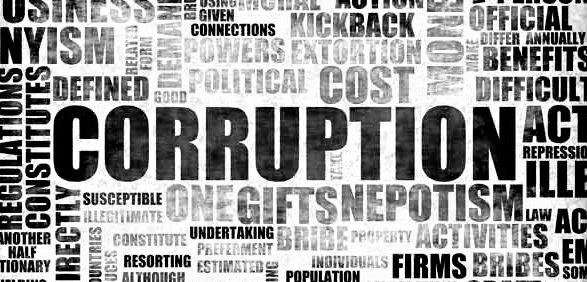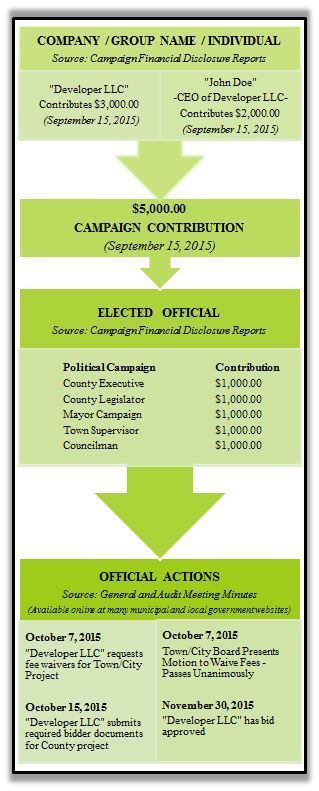
With so much attention focused on National and Statewide political campaigns, and all the nooks and crannies that go along with them, many of those on the more local level often go unnoticed and play out with a lot less scrutiny and very little, if any, oversight. Governing bodies on the local level are quite susceptible to the nefarious activities of bribery, nepotism, embezzlement, political patronage and extortion. In having so many competing interests and factors at play, in local politics, it can be a challenge finding evidence and empirical data that show indicators of these activities taking place.
Our political campaign process is one where financial contributions are, ideally, made to support candidates with views or platforms that a person, group or entity agree upon. This is what is commonly understood to be the legal and accepted intent of campaign donations. However, the potential is there for these contributions to become a form of bribery if it can be determined that the intent of the exchange was for official acts or decisions, prior or subsequent.
The Devil is in the Details
Albert Einstein once said that, “intelligence is not the ability to store information, but to know where to find it.” In the State of New York, as is the case in other states, a person can access a campaign finance report for individuals seeking public office. Similarly, local governments are required to make minutes of meetings available to the public with most of them being accessible online nowadays going back several years. For example a town government may have minutes for meetings of the town board, planning board, zoning board along with audit/workshop and special sessions. These are all meetings where official votes and actions by elected and/or appointed individuals take place.
These reports and documents contain useful information detailing the exchange of money in the form of political campaign contributions and official acts of those in elected office. In reviewing campaign finance reports you can list out the company, group or individual making contributions along with the date they were made. Once that information is determined, the next source of key data can be found in meeting minutes that illustrate an elected official’s involvement and vote. Reviewing such minutes can be tedious in going through the content of them to locate any matching names from the campaign contributors. Once these names are located within the minutes that information along with the official act performed and the date can be compared with the corresponding pertinent information from the campaign finance reports to determine if any correlation exists.

Chart: How information can be plotted out to examine relationships between campaign contributions and official acts made by those in elected office
Whose Contribution is it Anyway?
In reviewing various names of people and groups in campaign financial reports, alongside local government meeting minutes, information can sometimes be misleading as many times the individuals who are benefiting from official acts by those in elected office are making donations under shell LLC’s. The use of these shell corporations intentionally make it difficult, but not impossible, for the public to determine who is really behind the campaign contribution or entity listed in meeting minutes. Once that information is uncovered, on many occasions, it can be observed that both the individual behind the LLC and the LLC itself are contributing the maximum amount allowable to a campaign under the two different names, albeit from the same person. This then becomes a loophole that has effectively, and unethically, been taken advantage of to double the amount contributed to a specific campaign.

Diagram: Depiction of a campaign contribution appearing to procure an official act on behalf of the donor
The One Hit Wonder
While it is interesting to note that many campaign donations to these local politicians come from the same individuals cycle after election cycle, the curious ones that stick out the most are those that only appear once or twice. In many instances these type of donations occur by land developers, businesses or investors that have something to gain in a specific time window that requires local government cooperation.

Example of a campaign donor making a one time contribution three days prior to a meeting whereby an official act was taken with the result being of benefit to the donor
Watchdog Advocacy
With so much energy and focus of national watchdog groups investigating and combing through data looking for information that would equate to red flags in the Presidential, Congressional and Senate campaigns it would behoove activist groups of this nature to do the same in local town halls and county governments across the country. Governing bodies on the local political levels have long operated with very little, if much of any, real oversight. In the State of New York the ineffective approach to dealing with unethical and corrupt practices have resulted in studies and headlines identifying the politicians here as the most corrupt in the nation over the past few years.
Study proves NY politicians most corrupt in nation (The New York Post)
If the attention of these types of watchdog groups focused more on the behavior and practices of corruption playing out locally in our Town Halls, County Government Centers and in our Courts they would find a treasure trove of corrupt practice in the form of bribes, pay-to-play systems, kickback schemes, quid-pro-quo relationships and political landscapes rife with cronyism where many elected officials in both politics and law serve interests beneficial to themselves before those of the public.
People have long tolerated institutionally corrupt cultures in local levels of government, so much so they often become complacent to it or unaware how common it is. Often times elected officials in these local levels of government view themselves as the “big fish” in the pond and govern with a sense of impunity. If tougher reforms in campaign finance and ethics enforcement are not taken more seriously or pursued by those in higher office with a bit more grit than we cannot act surprised when more politicians reach higher offices and become convicted on charges of corruption. If the corrupt practices are stopped on the local levels, it may curtail the problem of them spreading to the higher levels of government.
RELATED ARTICLES BY STEPHEN KRASNER
